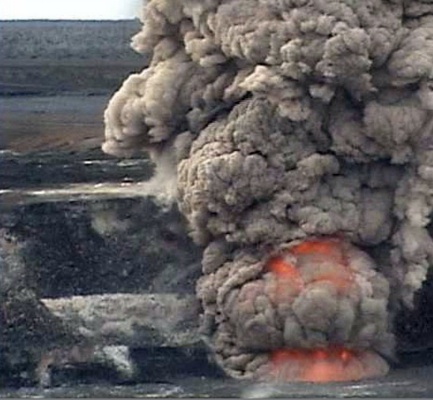
Kilauea Volcano's Deadliest Eruption Revealed

A band of ancient warriors were en route to battle near the summit of Mount Kilauea more than 200 years ago when Pele, the Hawaiian goddess that lives inside the volcano, got angry. Very angry.
Searing rocks exploded from Kilauea's summit crater and a thick current of lava surged toward the warriors, propelled by hurricane-force winds. More than 400 people died, according to historical estimates, in the deadliest volcanic eruption in what is now the United States.
"There have been more powerful eruptions here, but none more deadly," said Don Swanson, a geologist with the Hawaiian Volcano Observatory.
Kilauea's legendary eruption happened in November 1790, but until now the deadly surge of lava associated with it had yet to be identified, Swanson said during a news conference today (Dec. 6) at the annual meeting of the American Geophysical Union in San Francisco.
"We think that we've identified the very eruption, by its deposit, that was responsible for the deaths of so many people," Swanson said. And this eruption points to a more explosive past for Kilauea than thought. [History's Most Destructive Volcanoes]
Fieldwork also turned up footprints in the muddy ash not far from the Hawaiian observatory, Swanson said.
"One wonders if those footprints were the last that that person took," Swanson said.
Sign up for the Live Science daily newsletter now
Get the world’s most fascinating discoveries delivered straight to your inbox.
Eruptive spectrum
By carbon-dating explosive deposits and lava flows, Swanson built an eye-opening timeline of the volcano's history. Advancements in radiocarbon dating, along with dogged fieldwork, allowed Swanson to date tiny pieces of carbon, a task that wasn't possible just a few years ago
"He's found many, many more explosions than we thought existed," said Ken Hon, a volcanologist at the University of Hawaii at Hilo.
Violent eruptions are not synonymous with Kilauea. Its name means "spewing" or "much spreading" in Hawaiian and the volcano has been continually oozing out lava since Jan. 3, 1983. People often walk near these sluggish rivers of lava that flow down the mountain's slopes and into the ocean. These "gentle eruptions" are rarely a threat unless people are doing something foolish, Swanson said, but that hasn't always been the case.
Over the past 2,500 years, Kilauea has existed on the opposite end of its eruptive spectrum — in an explosive period — about 60 percent of the time, according to Swanson's new data.
"The major finding that we have is that these are not infrequent events," Swanson said.
Explosive again?
Kilauea is currently in a lava flow mode, as it has been for the other 40 percent of the past 2,500 years. During these quieter periods, the volcano begins to rebuild itself by piling lava flow on top of lava flow. Kilauea, however, could switch back to an explosive period without much warning, Swanson said, because scientists don't fully understand how these explosions begin. These powerful and dangerous volcanic periods can last hundreds of years.
"We don't know when the next period of explosive activity may start," Swanson said. "Is it a threat today? I think the answer is clearly yes," Swanson said.
Whenever Kilauea returns to an explosive mode, a long-term evacuation of the summit, a popular vacation spot, will be necessary.
You can follow OurAmazingPlanet staff writer Brett Israel on Twitter: @btisrael. Follow OurAmazingPlanet for the latest in Earth science and exploration news on Twitter @OAPlanet and on Facebook.










